
American sweetgum, also known as American storax, hazel pine, bilsted, redgum, satin-walnut, star-leaved gum, alligatorwood, or simply sweetgum, is a deciduous tree in the genus Liquidambar native to warm temperate areas of eastern North America and tropical montane regions of Mexico and Central America. Sweetgum is one of the main valuable forest trees in the southeastern United States, and is a popular ornamental tree in temperate climates. It is recognizable by the combination of its five-pointed star-shaped leaves and its hard, spiked fruits. It is currently classified in the plant family Altingiaceae, but was formerly considered a member of the Hamamelidaceae.
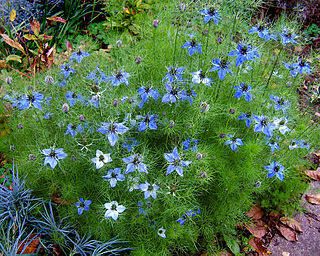
Nigella damascena, love-in-a-mist, or devil in the bush, is an annual garden flowering plant, belonging to the buttercup family Ranunculaceae. It is native to southern Europe, north Africa and southwest Asia, where it is found on neglected, damp patches of land.

Lansium parasiticum, commonly known as langsat, lanzones, or longkong in English; duku in Indonesian or dokong in Terengganu Malay, is a species of tree in the Mahogany family with commercially cultivated edible fruits. The species is native to Southeast Asia.

Euonymus japonicus is a species of flowering plant in the family Celastraceae, native to Japan, Korea and China. It is an evergreen shrub or small tree growing to 2–8 m tall, with opposite, oval leaves 3–7 cm long with finely serrated margins. The flowers are inconspicuous, greenish-white, 5 mm diameter. In autumn, orange fruit hangs below the flaring pink seed coverings.
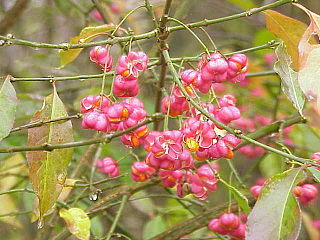
Euonymus europaeus, the spindle, European spindle, or common spindle, is a species of flowering plant in the family Celastraceae, native to much of Europe, where it inhabits the edges of forest, hedges and gentle slopes, tending to thrive on nutrient-rich, chalky and salt-poor soils. It is a deciduous shrub or small tree.

Euonymus alatus, known variously as winged spindle, winged euonymus, or burning bush, is a species of flowering plant in the family Celastraceae, native to central and northern China, Japan, and Korea.

Sandoricum koetjape, the santol, sentul or cotton fruit, is a tropical fruit native to maritime Southeast Asia (Malesia).

Euonymus atropurpureus is a species of shrub in the bittersweet family. It has the common names American wahoo, eastern wahoo, burningbush and hearts bursting with love. It is native to eastern North America.

Diospyros kaki, the Oriental persimmon, Chinese persimmon, Japanese persimmon or kaki persimmon, is the most widely cultivated species of the genus Diospyros. Although its first botanical description was not published until 1780, D. kaki is among the oldest cultivated plants, having been in use in China for more than 2000 years.

Euonymus fortunei, the spindle, Fortune's spindle, winter creeper or wintercreeper, is a species of flowering plant in the family Celastraceae, native to east Asia, including China, Korea, the Philippines and Japan. It is named after the Scottish botanist and plant explorer Robert Fortune. E. fortunei is highly invasive and damaging in the United States, causing the death of trees and forest in urban areas.

Rosa chinensis, known commonly as the China rose, Chinese rose, or Bengal rose, is a member of the genus Rosa native to Southwest China in Guizhou, Hubei, and Sichuan Provinces. The first publication of Rosa chinensis was in 1768 by Nikolaus Joseph von Jacquin in Observationum Botanicarum, 3, p. 7 & plate 55.

Euonymus pendulus is a species of Euonymus native to the Himalaya region, from Pakistan east to northern Assam.

Euonymus acanthocarpus is a species of flowering plant in the family Celastraceae. It is endemic to China. It has a scattered distribution in forest habitat.
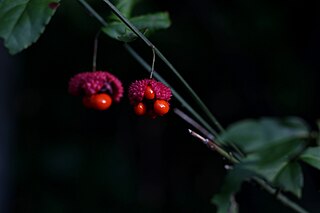
Euonymus americanus is a species of flowering plant in the family Celastraceae. Common names include strawberry bush, American strawberry bush, bursting-heart, hearts-a-bustin, and hearts-bustin'-with-love. It is native to the eastern United States, its distribution extending as far west as Texas. It has also been recorded in Ontario.

Euonymus occidentalis is a species of spindle tree known by the common names western burning bush and western wahoo.

Erica lusitanica is a species of flowering plant in the family Ericaceae, known by the common names Portuguese heath and Spanish heath. It is native to Portugal, Spain and southwestern France. It is named for Lusitania, a historical region encompassing most of modern Portugal and parts of western Spain.

Linaria purpurea or purple toadflax is a purple-flowered plant native to Italy, part of the plantain family (Plantaginaceae). It is sometimes planted in gardens and is also an introduced weed in North America and other parts of Europe.
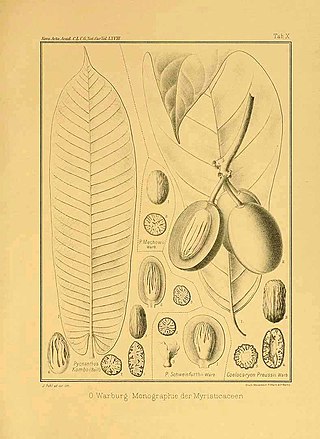
Pycnanthus angolensis is a species of tree in the nutmeg family, Myristicaceae. It is native to Tropical Africa. Its English language common names include African nutmeg, false nutmeg, boxboard, and cardboard. In Africa it is widely known as ilomba.
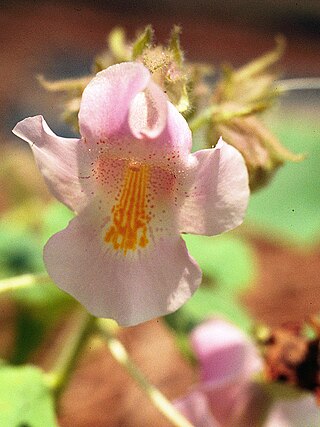
Proboscidea louisianica is a species of flowering plant in the family Martyniaceae. Its true native range is unclear, but probably includes parts of the southwestern United States and Mexico in North America. It occurs in other areas, including other regions in North America, Europe, Australia, and South Africa, as an introduced species. It is the most widely distributed species in its family. Common names it shares with other Proboscidea species include devil's claw and unicorn-plant. Names more specific to the species include common devil's claw, ram's horn, aphid trap, Louisiana unicorn-plant, purple-flowered devil's-claw, goat's head, and elephant tusks.

Euonymus sachalinensis, the flat-stalked spindle, is a species of flowering plant in the family Celastraceae, native to Japan, China, Korea, and the Island of Sakhalin. Growing to 2.5 m (8.2 ft) tall and broad, it is a deciduous shrub notable for its leaves turning red in autumn, and its red fruit which splits open to reveal orange seeds. Exceptional specimens, such as the one in the Hørsholm Arboretum, Copenhagen University, can become trees up to 4 m (13 ft) in height.

























